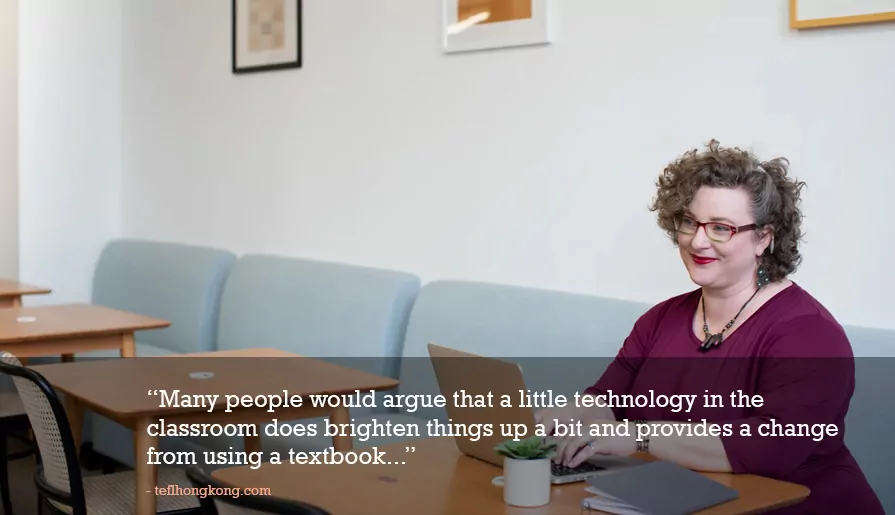
- By: Anna McIver
- In: ESL Activities
In an age where we are surrounded by technology, and everyone is seemingly attached to their phone, I pad or laptop, it makes sense to incorporate this into the classroom. Students generally love technology, and when we as teachers use it to enhance our lessons, we can invigorate, interest and inspire our ESL learners in new ways.
In this article, we will discuss why we feel technology holds such an important place in the modern ESL classroom and suggest some ways in which you can use it to both you and the student’s advantage. Although it is not necessary to include technology in every single class, a lot can be gained from using it occasionally. Students are likely to be interested, engaged and look forward to something a bit different.
The new electronic independence re-creates the world in the image of a global village.
– Marshall McLuhan
So, why the need to include technology in the classroom and what do we mean by this?
It is estimated that around 5 billion people worldwide have a mobile phone and that in Asia and Europe combined almost 70% of people have internet access. (https://www.internetworldstats.com/stats.htm)
With statistics such as these, we can see a clear trend in technology use across the world, meaning more and more of our students will be tech-savvy. Students understand, use and enjoy technology which is one reason why we can benefit from using it in our classes. It also means we have easy access to hundreds of audio and video clips, games, films- the list goes on.
Many people would argue that a little technology in the classroom does brighten things up a bit and provides a change from using a textbook.
It is not the be-all and end-all of course and should not be relied on all the time, but it is worth including now and then to liven things up!
Good, bad or indifferent, if you are not investing in new technology, you are going to be left behind.
So how can we incorporate technology into our ESL classes in a meaningful way? Here are just some of our suggestions:
- Videos and audio on Youtube
- Using Netflix to show episodes of series or using segments in class
- Encouraging students to record or video themselves as part of class projects or as homework tasks to assess later
- Have students download learning apps such as Duolingo or Busuu, which both allow users to make and track their progress. Speaking pal, another app, even allows you to have virtual conversations using short dialogues!
- We also recommend checking out this website for additional games and resources that you can use in your own classroom. https://www.eslgamesplus.com/ features lots of games for children but also some appropriate activities for older learners
Increase student engagement
Try using interactive games like Kahoot https://kahoot.com/, which require students to use their phones to log in and answer questions under timed conditions.
Questions appear on the classroom TV, or whiteboard and scores are then displayed on a screen. There are hundreds of quizzes available, many aimed at ESL learners or you can even create your own. Be aware that Kahoot requires an internet connection as well as mobile phones so may not be appropriate for all classes.
Expose students to new accents and different cultures
A friend at my previous school used Skype several times to practise interview techniques, speaking skills and create enthusiasm and interest with students.
She would line up a friend or family member who would be available to Skype during class time, and students would have previously prepared questions to ask.
Sometimes these were cultural or more specific using vocabulary or referring to topics that students had just covered. This always went down well with students and does not require anything more than a laptop and internet connection.
Listening and speaking practice
Another technique that was used in a school I worked in was using podcasts. There are so many from different countries and countless topic areas that it is easy to find something suited to your class. You can set listening as homework or listen in class and then students can create their own, following guidelines set out by you. You can even take this one step further and have them record themselves if technology allows.
Creating a class Whatsapp group with adult learners is a great way to help them continue to practice outside the classroom. Many students struggle as they don’t have opportunities to continue speaking English between classes and this approach allows them to do so.
For example, you could set a specific homework, like asking students to write a short paragraph each day about what they have done and sending it to the group, which can then be referred back to in class to check any errors. Another option is to send a voice note as the teacher and have students transcribe what they heard.
There are lots of options when it comes to Whatsapp, make sure you set appropriate ground rules first about sharing phone numbers.
Technology has advanced more in the last thirty years than in the previous two thousand. The exponential increase in advancement will only continue.
– Niels Bohr
Although not every student you teach will have a phone – and in some locations, the internet connection may be unreliable. Under such situations, bringing technology into the classroom even in small ways is important and will help students to interact, and solve the problems in new and meaningful ways. It also encourages more active learning and depending on the activity often provides instant results and feedback for both students and teachers.
It goes without saying that technology can enhance the ESL classroom, and it doesn’t need to be too complex or too over the top. Simple activities like video clips, audio and online games make a great change from course books that can sometimes lack innovation and need spicing up! So why not try out some new techniques with your classes and see how you get on?
Please Share:This article was originally published on November 25, 2019 and was last updated on July 13, 2020.
Courses We Offer:

1. CertTESOL: Certificate in TESOL
A level 5, initial teacher training qualification for new and experienced teachers, enabling you to teach English anywhere in the world. The course is equivalent to Cambridge CELTA.
Learn More
Developed by our Trinity CertTESOL experts, for a comprehensive, self-paced learning experience. Earn an internationally recognized certificate and master essential teaching skills, accessible globally 24/7.
Learn More